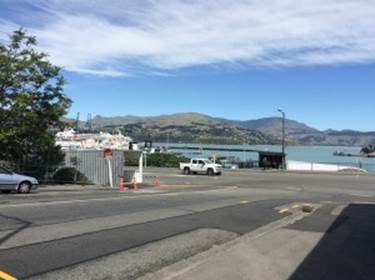The NZ Transport Agency and its Lyttelton working group partners have agreed upon the best location for a new “smart” pedestrian crossing at the western end of Norwich Quay.
The crossing project is designed to improve safety for pedestrians on a busy section of State Highway 74 while also maintaining road freight efficiency to and from the Port.
The preferred crossing location between Sutton Quay and Canterbury St fits in with future plans to shift the Diamond Harbour Ferry from the east end of the Lyttelton Wharf area to Dampier Bay on the western end. The project is part of the wider development of the Port area covered by the Lyttelton Port Recovery Plan(external link).

A view of Norwich Quay and Lyttelton Harbour from Dublin St to the existing bus shelter.
“We are undertaking this project with a working group of community representatives, members of the Lyttelton Mt Herbert Community Board and partners to the Lyttelton Port Recovery Plan, namely Christchurch City Council, Environment Canterbury, the NZ Transport Agency and the Lyttelton Port Company,” says Colin Knaggs, Highway Manager for the Transport Agency.
After looking at three possible locations, and various crossing options, the working group agreed that a “smart” signalised pedestrian crossing will be installed between Sutton Quay and Canterbury St.
“A survey of pedestrians and bus users on Norwich Quay identified where people are currently crossing and their perspectives on proposed improvements. Naturally people wanted a pedestrian crossing as close as possible to their path of travel, but the majority of people agreed with the proposed location and the relocation of the bus stop as a good option. This catered for both existing users, and the anticipated future users accessing the redevelopment of Dampier Bay,” Colin Knaggs said.
A public information sheet explaining the new pedestrian facility has been distributed in Lyttleton this week so people are aware of how and why the site and style of crossing has been chosen.
“Smart” traffic signals use radar sensor technology to identify the presence of pedestrians and vehicles and initiate the crossing phase to ensure road safely and also maintain efficiency for trucks accessing the Port.
When people press the pedestrian button the detectors check for traffic on Norwich Quay and the “Cross Now” sign will activate soon after. If there is a truck approaching they may have a short wait.
The cost of the signals is expected to be around $300,000 and subject to approvals, they could be operational by Christmas.
What did those surveyed say about the preferred option?
Nearly 90% said they would use this crossing location to access public transport, work and education facilities. While many survey respondents wanted a pedestrian crossing close to their particular walking routes, they agreed this location that included shifting the bus stop was good because it provided a safer option, particularly for seniors and young people.
What are some of the advantages of this option?
It’s located in an area where the road is narrower and away from most complex traffic movements further west. This option also includes relocating the bus stop and shelter to this site, something favoured by pedestrians and bus users along Norwich Quay who were surveyed. It also caters for both existing users and future pedestrian demand from the redevelopment of nearby Dampier Bay. In addition to this, it will deliver increased safety for students walking to the new Lyttelton Primary School on the east side of the town.
Are there any impacts on car parking?
Ten car parks will be lost so there is enough space for the new crossing and relocated bus stop and shelter, and to ensure good visibility for both motorists and crossing users. Plenty of alternative parking is available nearby.